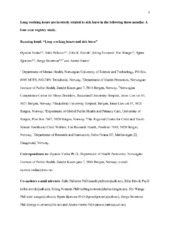| dc.contributor.author | Vedaa, Øystein | |
| dc.contributor.author | Pallesen, Ståle | |
| dc.contributor.author | Erevik, Eilin K. | |
| dc.contributor.author | Svensen, Erling | |
| dc.contributor.author | Waage, Siri | |
| dc.contributor.author | Bjorvatn, Bjørn | |
| dc.contributor.author | Sivertsen, Børge | |
| dc.contributor.author | Harris, Anette | |
| dc.date.accessioned | 2019-08-01T07:28:03Z | |
| dc.date.available | 2019-08-01T07:28:03Z | |
| dc.date.issued | 2019-05 | |
| dc.Published | Vedaa Ø, Pallesen S, Erevik Eilin K., Svensen E, Waage S, Bjorvatn B, Sivertsen BS, Harris A. Long working hours are inversely related to sick leave in the following 3 months: a 4-year registry study. International Archives of Occupational and Environmental Health. 2019;92(4):457–466 | eng |
| dc.identifier.issn | 1432-1246 | |
| dc.identifier.issn | 0340-0131 | |
| dc.identifier.uri | https://hdl.handle.net/1956/20620 | |
| dc.description.abstract | Purpose: The aim of this study was to investigate the effects of long working hours (≥ 12 h shifts) on sick leave using objective records of shift work exposure and of sick leave. Methods: A total of 1538 nurses (mean age 42.5, SD 12.0; response rate 42%) participated. Payroll and archival sick leave data over a 4-year period were retrieved from employers’ records and aggregated over every third calendar month. A multilevel negative binomial model was used to investigate the effects of exposure to long working hours, on subsequent sick leave rates the following 3 months. Covariates included prior sick leave, number of shifts worked, night and evening shifts, personality, and demographic characteristics. Results: Exposure to long working hours was associated with fewer sick leave days in the subsequent 3 months [adjusted model, incidence rate ratio (IRR) = 0.946, 95% CI 0.919–0.973, p < 0.001]. The interaction long working hours by a number of work days showed that sick leave days the subsequent 3 months was higher by long shifts when number of shifts was high compared to when number of shifts was low [adjusted model, IRR 1.002, 95% CI 1.000–1.004, p < 0.05]. Discussion: Long working hours was associated with fewer sick leave days. The restorative effects of extra days off with long working hours are discussed as possible explanations to this relationship. | en_US |
| dc.language.iso | eng | eng |
| dc.publisher | Springer | eng |
| dc.subject | Long working hours | eng |
| dc.subject | Extended daily working hours | eng |
| dc.subject | Long shifts | eng |
| dc.subject | Sick leave | eng |
| dc.subject | Sickness absence | eng |
| dc.title | Long working hours are inversely related to sick leave in the following 3 months: a 4-year registry study | eng |
| dc.type | Peer reviewed | |
| dc.type | Journal article | |
| dc.date.updated | 2019-04-24T10:33:49Z | |
| dc.description.version | acceptedVersion | |
| dc.rights.holder | Copyright Springer-Verlag GmbH Germany, part of Springer Nature 2018 | eng |
| dc.identifier.doi | https://doi.org/10.1007/s00420-018-1372-x | |
| dc.identifier.cristin | 1629581 | |
| dc.source.journal | International Archives of Occupational and Environmental Health | |
